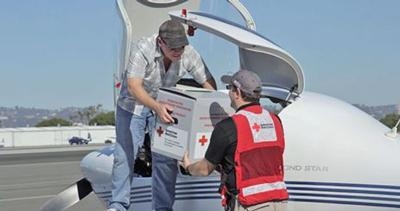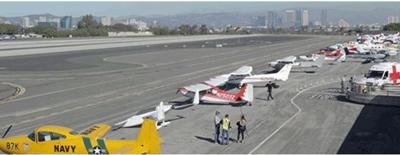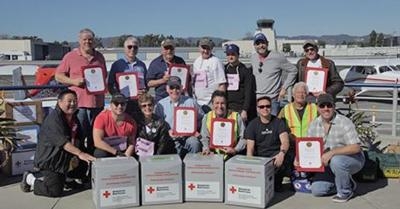Ten Aircraft Participate In Simulated Natural Disaster Exercise
On the otherwise unremarkable morning of Jan. 14, 10 airplanes from five airports across Los Angeles County landed at Santa Monica Municipal Airport (KSMO), to demonstrate the importance of the historic airfield in serving the community during times of crisis.

In a simulated disaster-response exercise, pilots in the drill hopped out of their airplanes and immediately began unloading boxes marked “Water Purification” or “Emergency Shelters,” and quickly handed off the supplies to Red Cross volunteers.
In this exercise at Santa Monica, the DART volunteers simulated an earthquake that has closed the 405 and 10 Freeways, and the Pacific Coast Highway. In the scenario, KSMO’s runway could be damaged, but still usable.
Together, the 10 planes involved in the scenario could carry over 2,000 pounds of supplies into KSMO, and if needed, could fly five missions per day, getting critical supplies to Red Cross volunteers on the ground, as well as the hospitals they serve.
“LA-area hospitals depend on us, because the Red Cross provides 40 percent of the nation’s blood supply,” said Jeanne Woo, disaster program manager for the Red Cross Los Angeles Region. “So, any disruptions to logistics can cause huge shortages of blood.”

During the Northridge earthquake of 1994, “a section of the 10 Freeway cracked and broke,” snarling the relief efforts of first responders and the Red Cross, said Woo, “so we’re seeing how volunteer pilots might be another way to deliver services, when communities get cut off. If they can land 10 airplanes in one hour, and each of them can carry 30 packets of blood, that could be a significant contribution.”
The pilots and volunteers in attendance showed how KSMO, as formally confirmed in city records, serves as an irreplaceable hub for emergency response. Those involved in the simulation are known as Santa Monica Airport’s Disaster Airlift Response Team (DART).
“Our mission is to activate in an emergency, and act as an air bridge for the Red Cross and incident commanders,” said Dave Hopkins, vice president of the Santa Monica Airport Association (SMAA). “A drill like this is a practical example of how we could use the airport as critical infrastructure in case of an emergency.”
In fact, the City of Santa Monica’s All Hazards Mitigation Plan (a state-mandated preparedness document for all California cities) lists KSMO among the “facilities critical to government response and recovery.” It’s a function served by general aviation (GA) airports across the country, and the DART concept came out of GA pilots’ response to California’s devastating Loma Prieta earthquake of 1989.

More than 30 Red Cross and SMAA volunteers played essential roles in the DART exercise, such as dispatching flights, marshalling aircraft, loading and stockpiling supplies. Volunteer pilots flew from Van Nuys, Whiteman, Brackett Field, Compton/Woodley and Torrance Airports. The supplies used in the Jan. 14 simulation were later donated to local charities.
Like SMAA, the Torrance Airport Association (TAA) has also assembled a DART team and is planning their own emergency preparedness drill, according to TAA Member Anne O’Brien, who flew into KSMO for the Jan. 14 exercise. “As soon as the city council, mayor and city manager see the capabilities of the airport for disaster response,” she said, “they get it.”
(Images provided with NBAA news release)
 ANN's Daily Aero-Term (05.29.25): Terminal Radar Service Area
ANN's Daily Aero-Term (05.29.25): Terminal Radar Service Area ANN's Daily Aero-Term (05.30.25): Very High Frequency (VHF)
ANN's Daily Aero-Term (05.30.25): Very High Frequency (VHF) Aero-News: Quote of the Day (05.30.25)
Aero-News: Quote of the Day (05.30.25) Airborne 05.23.25: Global 8000, Qatar B747 Accepted, Aviation Merit Badge
Airborne 05.23.25: Global 8000, Qatar B747 Accepted, Aviation Merit Badge ANN's Daily Aero-Linx (05.30.25)
ANN's Daily Aero-Linx (05.30.25)





